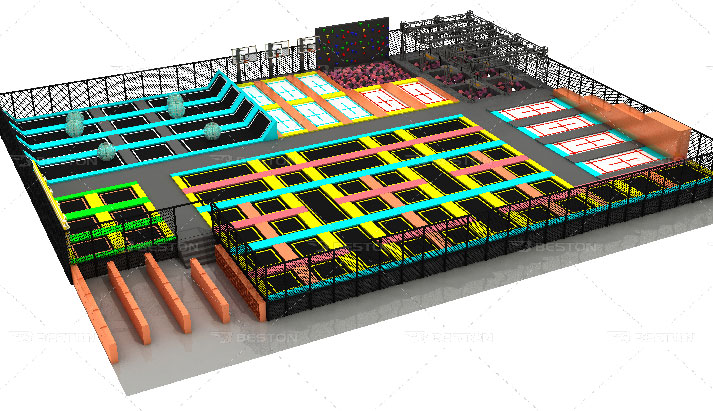Building a new trampoline park in the Philippines can be an exciting venture, as it offers a unique and engaging entertainment option for both children and adults. However, it’s essential to plan and execute the project carefully to ensure its success. Here are the steps to consider when building a new trampoline park in the Philippines:
1. Market Research and Feasibility Study:
Conduct thorough market research to assess the demand for a trampoline park in the chosen location within the Philippines. Identify potential competitors and target demographics.
Evaluate the economic viability of the project by analyzing projected costs, revenue streams, and return on investment (ROI).
2. Location Selection:
Choose a prime location with high visibility and accessibility. Proximity to residential areas, schools, and shopping centers can be advantageous.
Consider factors like parking availability and ease of transportation for customers.
3. Business Plan Development:
Create a comprehensive business plan that outlines your concept, target audience, marketing strategy, financial projections, and operational plan.
Include details on the park’s design, size, and features you plan to offer.

4. Legal and Regulatory Compliance:
Consult with local authorities to understand the legal requirements and regulations for operating an indoor amusement facility. This may involve permits, licenses, safety standards, and zoning regulations.
Ensure compliance with safety standards such as ASTM International F2970-13, which outlines safety requirements for trampoline park equipment for sale.
5. Secure Financing:
Determine the budget required for the project, including construction costs, equipment, insurance, marketing, and working capital.
Explore financing options, such as bank loans, investors, or grants, to secure the necessary funds.
6. Facility Design and Construction:
Work with architects and contractors to design and build the trampoline park. Consider factors like layout, safety features, and aesthetic appeal.
Install high-quality trampoline equipment and safety features, including padding, netting, and foam pits.
7. Safety Protocols and Training:
Develop comprehensive safety protocols and training programs for staff members.
Ensure that all employees are well-versed in safety procedures, first aid, and emergency response.
8. Marketing and Branding:
Create a strong brand identity and marketing strategy. Develop a website, social media presence, and promotional materials.
Consider partnerships with local schools, community organizations, and businesses to promote the trampoline park.
9. Staffing:
Hire and train staff members, including managers, attendants, and maintenance personnel.
Emphasize customer service and safety in staff training.
10. Pre-Opening Marketing Campaign:
– Launch a pre-opening marketing campaign to generate buzz and anticipation for the trampoline park.
– Offer special promotions, discounts, or memberships to early customers.
11. Grand Opening:
– Host a grand opening event with activities, giveaways, and special offers to attract customers on the opening day.
– Invite local media outlets to cover the event for increased visibility.
12. Ongoing Operations:
– Continuously monitor and maintain trampoline equipment to ensure safety and functionality.
– Implement a reservation and booking system to manage customer flow efficiently.
– Regularly update and refresh the park’s features to keep customers engaged and coming back.
13. Safety and Risk Management:
– Establish a risk management plan to minimize accidents and liability.
– Invest in liability insurance coverage to protect your business and assets.
14. Customer Feedback and Improvement:
– Solicit customer feedback through surveys or comment cards to identify areas for improvement.
– Act on feedback to enhance the overall customer experience.
15. Marketing and Promotion:
– Maintain an ongoing marketing strategy to attract new customers and retain existing ones.
– Consider hosting special events, parties, and promotions to keep the park busy during off-peak hours.
16. Financial Management:
– Continuously monitor financial performance and adjust the budget as needed.
– Keep a close eye on expenses, revenue, and cash flow to ensure the park’s financial sustainability.
Building a trampoline park in the Philippines by clicking www.amusementrides.ph can be a rewarding venture that offers unique entertainment options for families and individuals. By carefully following these steps and prioritizing safety, quality, and customer experience, you can increase your chances of success in this exciting business opportunity.
